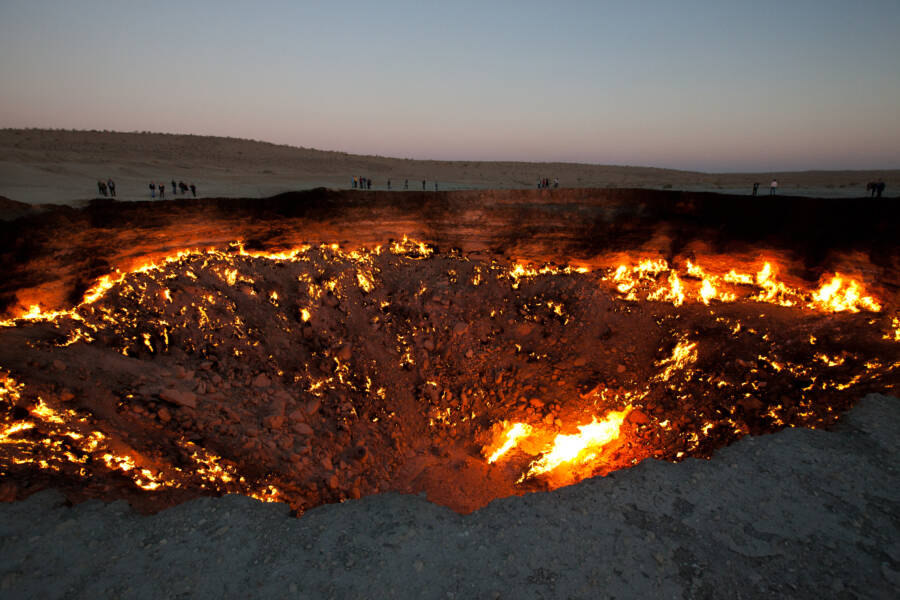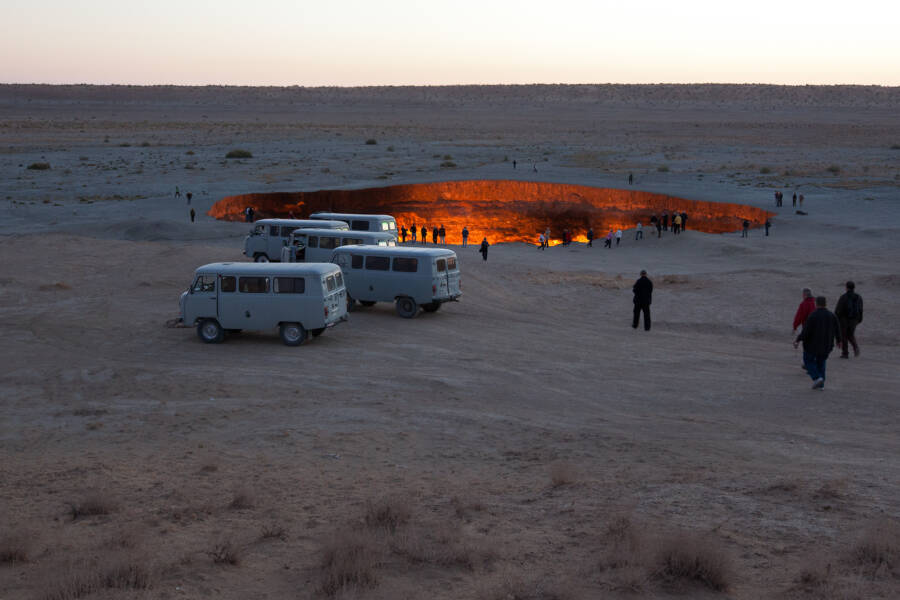Turkmenistan's "Door to Hell," also called the Darvaza gas crater, is fueled by a reserve of methane gas below the surface — and scientists have no idea how long it will take to burn out.

Martha de Jong-Lantink/FlickrThe Darvaza gas crater, better known as the “Gates of Hell,” was unearthed during a failed Soviet oil drilling expedition in 1971.
While many deem heaven and hell the stuff of religion and mythology, the locals of Darvaza, Turkmenistan, might beg to differ. After all, the “Gates of Hell” have been wide open in their desert since 1971. While neither Satan nor his band of fallen angels climbed out of the Darvaza gas crater, an endless supply of methane has — and it has yet to stop burning.
Formally known in Turkmen state media as the Shining of the Karakum, the infernal pit is 160 miles from the capital of Ashgabat. It spans a whopping 230 feet across with a depth of 70 feet. And although it’s a popular tourist site, the continuous stream of methane has impacted the health of local wildlife and residents.
The Soviet drillers who first discovered the gas crater were initially hoping to strike oil. They thought setting it on fire would burn off any excess gas within weeks, but there’s been no end in sight for the resulting blaze. That is until January 2022, when President Gurbanguly Berdymukhamedov ordered it to be extinguished once and for all.
How Turkmenistan’s Gates Of Hell Began To Burn
Otherwise known as the “Door to Hell,” the Darvaza gas crater is located deep in the Turkmenistan desert. The glow from its continuous flames can be seen for miles across the central Karakum Desert and is a continuous sight for the 350 villagers who dwell in Darvaza.

Martha de Jong-Lantink/FlickrThe “Gates of Hell” crater is 190 feet wide and 70 feet deep.
The Cold War was in full swing when the Soviets accidentally created the crater. Geologists believed the area was rich in oil and claimed the region when things went awry. Beneath the ground they prepared to drill in 1971 was a colossal pocket of natural gas, with only a thin crust of earth masking the fact.
When geologists began drilling, the thin crust crumbled into its own footprint as it became unable to support the weight of the heavy Soviet machinery. The entire site collapsed, beginning a domino effect that resulted in craters opening across the thin desert plain. The geologists rapidly realized they had a problem.
Not only had the Gates of Hell swallowed their drilling equipment, but it was now leaking natural gas. Though the gas was primarily non-toxic methane, it can make it hard to breathe. It didn’t take long for the local wildlife that roamed the Karakum Desert to suffer. Before long, they began to die.
Furthermore, methane gas has high flammability — with air containing only five percent methane capable of causing a massive explosion. The high levels seeping from the Door to Hell thus made the area highly susceptible to a significant disaster. The experts soon decided that the practice of “flaring” was in order.

Martha de Jong-Lantink/FlickrThe methane gas has caused health issues for locals and regional wildlife.
This approach uses a controlled burn to eliminate excess gas and is standard practice in many natural gas drills. Unfortunately, the geologists in Karakum didn’t know how much gas they were dealing with. Setting up a flare, they lit the Door to Hell on fire — causing an endless blaze that hasn’t ceased in over half a century.
Turning The Darvaza Gas Crater Into A Tourist Site
Some geologists in Turkmenistan believe the crater might have been formed as early as the 1960s. They’ve even posited that the crater was only set on fire in the 1980s. Nonetheless, it appears to have been burning for several decades before President Berdymukhamedov visited the site and began pondering solutions.
In 2010, he ordered geologists and relevant authorities to find a way to extinguish the blaze. As the leader of the fifth-highest natural gas-exporting country globally, Berdymukhamedov worried that the eternal flames would make drilling other gas fields impossible — and that this could severely hamper significant income for Turkmenistan.

sunriseOdyssey/FlickrPresident Gurbanguly Berdymukhamedov first ordered the fire to be extinguished in 2010.
But geologists were unable to figure out how to put out the flames. The Gates of Hell has since become a cordoned-off tourist attraction, complete with a nearby campsite walking distance to the rim.
Furthermore, locals report a pastime of watching swarms of spiders dazzled by the flames launching themselves into the pit. And in 2013 — protected by heat-resistant gear — Canadian-born explorer George Kourounis followed suit.
“[Climbing into the Gates of Hell] felt like being on another planet,” he said. “The walls are lit up. Everything is glowing orange from the fire. There’s poisonous gas everywhere.”
While the Darvaza gas crater has spurred some additional tourism, that industry is rather small for the nation. It’s not easy to enter Turkmenistan, where visitors need a special visa coordinated by a travel agency.
And now, with growing health concerns for both people and animals, the president has renewed efforts to put the fire out.
Closing The Gates Of Hell
President Gurbanguly Berdymukhamedov, first elected in 2006, has spent the last 15 years building colossal government buildings, monuments, and a new airport in the capital. Before the COVID-19 pandemic, the number of foreign tourists reached only the low tens of thousands — and locals have wanted the “Gates of Hell” closed for years.
But in 2019, Berdymukhamedov brought renewed attention to the Darvaza gas crater when he drove doughnuts around the crater to squash rumors of his death. Fortunately for locals, he has since taken the matter more seriously.

Altyn AsyrIn 2019, President Berdymukhamedov drove doughnuts around the “Gates of Hell” to squash rumors of his death.
During a televised appearance on Jan. 8, 2022, the president said he has again ordered experts to “find a solution to extinguish the fire.” The Turkmenistan leader stated firmly that an international approach wasn’t off the table and that foreign consultants were welcome to help in the endeavor.
Berdymukhamedov said that the fiery crater “negatively affects both the environment and the health of the people living nearby. We are losing valuable natural resources for which we could get significant profits and use them for improving the well-being of our people.”
Turkmenistan’s government has yet to release a timeline for extinguishing the Darvaza gas crater. And if no solution is forthcoming, it will simply continue to burn until the methane runs out, although scientists have no idea how long that could be.
Enjoy this look at the Darvaza gas crater? Next, check out Centralia, the town in Pennsylvania that’s been on fire for more than 50 years. Then, read about another famous entryway in Turkey, dubbed the “Portal to Hell”.





